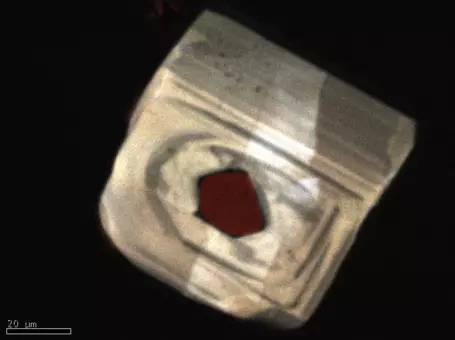Probability - Practice Problems
Solving Earth science problems with probability
This module is undergoing classroom implementation with the Math Your Earth Science Majors Need project. The module is available for public use, but it will likely be revised after classroom testing.
Sedimentology

Flood deposits, Idaho.
Many types of sedimentary beds are deposited during events such as floods, storms, or mobilization of turbidity currents. Probabilities govern when such events occur and influence the resulting stratigraphy.
Problem 1: Each year in the spring, a given river in the southwestern US may flood. To assess the flood hazard in the area, you collect a sediment core from the river floodplain that reveals 15 distinct major floods in the past 500 years. What is the probability of a major flood in a given year?
We solve the problem using these steps:
Step 1. Determine the type of problem.
The problem asks for the probability of one event in a single given year. This is a probability of occurrence problem.
Step 2. Determine the probability of occurrence of the outcome of interest.
The outcome of interest is flooding. There is a potential for flooding each year, and there have been 15 floods over the past 500 years. The number of outcomes of interest is 15 and the total number of observations is 500. Thus, the probability of flooding in a given year is 15/500 = 0.03.
Hurricane prediction

A hurricane off the coast of Florida.
High-intensity, category 5 hurricanes can have devastating impacts on coastal communities. In order to budget for hurricane response, we need to know how often we can expect to experience these hurricanes.
Problem 2: There have been 4 recorded category 5 hurricanes that have made landfall in the US in the last 100 years . What is the probability of having at least one category 5 hurricane over the next 5 years?
Let's break up this problem into two parts.
Step 1. Determine the type of problem.
The question asks for the probability of at least one outcome of interest over a defined time interval, in this case 5 years. This is a probability of occurrence over an interval problem.
Step 2. Determine probability of occurrence.
We can estimate the likelihood of a category 5 hurricane in a given year by dividing the number of category 5 hurricanes by the number of years, or 4/100. So there is a probability of 0.04 or a 4% chance of a category 5 hurricane occurring each year.
Step 3. Determine the probability of a non-occurrence outcome using the complement rule.
Using the probability calculated in Step 2, by the complement rule, the probability of not having a category 5 hurricane in a given year is 1 - 0.04 = 0.96, or 96%.
Step 4. Determine the probability of non-occurence over the interval using the exponent rule.
The non-occurrence probability of a category 5 hurricane in a given year is 0.96 and the specified interval is 5 years. By the exponent rule, the probability of no category 5 hurricane in the next 5 years is 0.965 = 0.82. There is an 82% chance that there will be no category 5 hurricane in the next 5 years.
Step 5. Determine the probability of at least one occurrence over the interval using the complement rule.
By the complement rule, the probability of having at least 1 category 5 hurricane in the next 5 years is 1 - 0.82 = 0.18. There is an 18% chance that there will be a category 5 hurricane over the next 5 years.
Landslides

Landslide
Landslides are mass wasting events that occur when the forces promoting collapse of a hillslope exceed the strength of the hillslope materials. Landslides are often triggered by large rainstorms when rapid groundwater infiltration reduces the cohesion, and therefore strength, of hillslope materials.
Problem 3: Imagine that in your community, landslides have occurred 10% of the time that storms have dropped over 3 inches of rain in 24 hours. Over how many such storms would the total probability of landsliding exceed 50%?
We'll solve this problem using the following steps:
Step 1. Determine the type of problem.
The question asks for the length of the interval (number of storms) over which the probability of an outcome would exceed a certain probability threshold (50%). This is an interval needed to achieve a certain probability problem.
Step 2. Determine the probability of occurrence.
The problem states that landslides have occurred 10% of the time that the rainstorms described in the problem have occurred. The probability of occurrence is 0.1.
Step 3. Determine the probability of non-occurrence using the complement rule.
Solve for the probability that there is not a landslide in a given storm using the complement rule:
$P(\text{no landslides per storm}) = 1 = 0.10 = 0.9$
Step 4. Plug the probability of non-occurrence over an interval and the probability of interest into the logarithm equation.
Recall that for this type of problem, the length of the interval needed can be found using this equation:
$N = log_{\text{(prob. of non-occurrence)}}(-(\text{prob. of interest}-1)) = N$.
We want to know how many storms it will take to have a 50% chance of having a landslide, so our probability of interest is 0.5. We can plug this value and our probability of non-occurrence into that equation.
$N = log_{0.9}(-(0.5-1))$
Step 5. Evaluate the logarithm to find N.
Using your preferred calculator or computer, solve:
$N = log_{0.9}(-(0.5-1)) = 6.58$
Thus, there is a greater than 50% probability of landsliding over 7 or more storms.
Geochronology

Zircon grains are used for U/Pb dating.
Geochronology is the field of measuring the numerical dates and rates of Earth processes. Many geochronological techniques use measurements of radioactive isotopes and their daughter products to calculate ages. For example, volcanic ash beds in sedimentary rocks can be dated by counting radioactive atoms and their daughter products in particular mineral phases. Radioactive decay over time is measured in terms of half-life, the amount of time after which approximately one half of a group of radioactive atoms will have decayed into their daughter product. For example, the half-life of uranium-238, a common radioactive isotope, is ~4.5 billion years, so about half of existing uranium-238 atoms will have decayed into lead-206, its stable daughter product, after ~4.5 billion years. For an individual radioactive atom, when the atom decays is random, and the probability of an individual atom decaying over one half-life is 0.5 by definition.
Problem 4: For a single uranium-238 atom, how likely is it that it will have decayed within 13.5 billion years from now?
Answer the question by following these steps:
Step 1. Determine the type of problem.
The problem asks for the probability that a given event (radioactive decay) will occur over a defined interval (13.5 billion years). This is a probability of occurrence over an interval problem.
Step 2. Determine the probability of occurrence of the outcome of interest.
The problem states that the probability of radioactive decay over a single half-life is 0.5.
Step 3. Determine the probability of non-occurrence by the complement rule.
By the complement rule, the probability that a given radioactive atom does not undergo radioactive decay in one half-life is 0.5.
Step 4. Determine the probability of non-occurrence over the certain interval using the exponent rule.
The problem states that the interval of interest is 13.5 billion years. Because the half-life of uranium-238 is 4.5 billion years, the interval of interest in terms of half-lives is
$\frac{\text{13.5 billion years}}{\text{4.5 billion years}} = 3$.
By the exponent rule, the probability of the atom not decaying over 3 successive half-lives is calculated as follows:
$P(\text{not decaying over three half lives}) = P(\text{not decaying over one half life})^3 = 0.5^3 = 0.125$
There is a 12.5% chance that the uranium-238 atom will not decay over 3 half-lives.
Step 5. Determine the probability of at least one occurrence over the interval using the complement rule.
By the complement rule, since the probability of not decaying over 3 half-lives is 0.125, the probability of decay over 3 half-lives is 1 - 0.125 = 0.875. There is an 87.5% chance that the uranium-238 atom will undergo radioactive decay within 3 half-lives, or 13.5 billion years.
Gold Rush

Gold miners in El Dorado, California.
Let's imagine you're a gold miner in the 1840s California Gold Rush. During the Gold Rush, miners rushed to California to establish mining claims in the Sierra Nevada mountain range. From asking other trustworthy miners about their findings, you have learned that out of 400 acres of mining claims, only 4 have been found to have gold. You are trying to figure out how many acres for which to purchase mining claims using your knowledge of probability.
Problem 5: How many acres do you need to claim to have an overall >50% chance of finding gold?
Step 1. Determine the type of problem.
The problem asks for the size of the interval (in this case, number of acres) needed to achieve an overall probability threshold for an event of interest (in this case, a >50% chance to find gold). This is an interval needed to achieve a certain probability problem.
Step 2. Determine the probability of occurrence.
The problem states that there are 4 acres with gold occurrences across 400 total acres. The probability of the outcome of an occurrence of interest is therefore $\frac{4}{400} = 0.01$.
Step 3. Determine the probability of non-occurrence using the complement rule.
Next we need to determine the probability of not finding gold on an acre, which we can solve for by subtracting the probability of occurrence from one.
$P(\text{no gold}) = 1 - 0.01 = 0.99$
Step 4. Plug the probability of non-occurrence over an interval and the probability of interest into the logarithm equation.
Remember that our general equation for solving for N, the length of the interval of interest, is:
$N = log_{P(\text{non-occurrence outcome})}(1 - P(\geq\text{1 outcome of interest over interval N}))$
Substitute the non-occurrence outcome and the target probability for an outcome over the interval into this equation:
$N = log_{0.99}(1 - 0.5) = log_{0.99}(0.5)$
Step 5. Evaluate the logarithm to find N.
Using your favorite computer or calculator method, evaluate the logarithm:
$N = log_{0.99}(1 - 0.5) = log_{0.99}(0.5) = 69.0$
So, you would need to make mining claims on 69 acres to have an overall >50% likelihood of finding gold.
Next steps
TAKE THE QUIZ!!
I think I'm competent with probability and I am ready to take the quiz! This link takes you to WAMAP. If your instructor has not given you instructions about WAMAP, you may not have to take the quiz.Or you can go back to the XXX explanation page.





